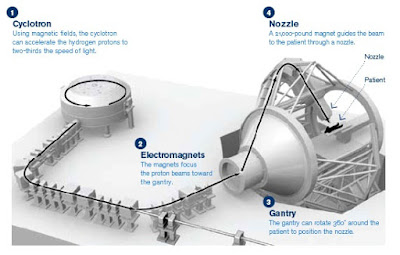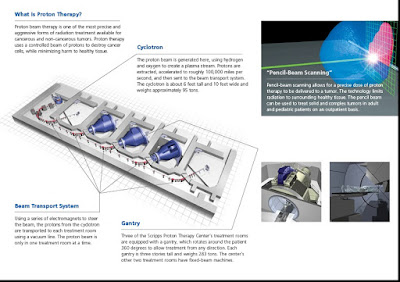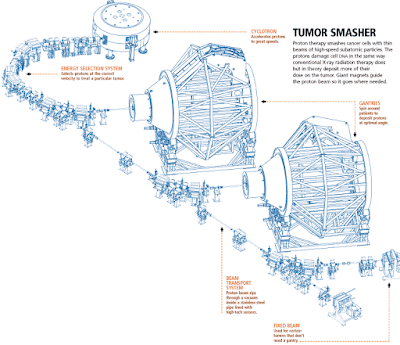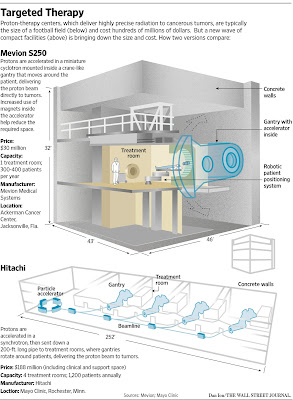Introduction To Proton therapy
Proton therapy is a radio beam therapy that is capable to deliver radiation through the skin with much-reduced pain compared to conventional radiation therapies. It is a technique which uses proton beam which is delivered to the tumor in a precise way where the surrounding tissue is left unharmed contrary to other procedures which damage the tissue to a smaller or greater extent.
A proton is a positively charged particle. At high energy, protons can destroy cancer cells.This technique may forever alter the nature of cancer treatment.
Proton Therapy Working procedure
Protons are atoms that carry a positive charge, similar to X-Rays which contain photons and is used to treat benign as well as malignant tumors but the only difference here is that it delivers protons in a much more confined and precise way, After they enter the body, protons release most of their energy within the tumor region and, unlike photons, deliver only a minimal dose beyond the tumor boundaries the shape and size of the tumor is also not a big problem as the method divide the tumor into small pixels and the radiations are given on these small pixels.
Therefore, especially for smaller tumor sizes, the radiation dose may conform much tighter to the tumor and thus it can lead to reduced damage to healthy surrounding tissue.
A proton is a Hydrogen atom without its orbiting electron and consist of a positive charge this positive charge attracts electrons from the nearby atom changing its structure this is responsible for the change in the structure of the deoxyribonucleic acid (DNA) when DNA strands are damaged to a smaller extent the gene p53 also known as guardian of the genome uses enzymes which repair the DNA but when DNA is severely damaged the p53 instead of giving repair signals to the genome start giving apoptotic signals (a way to organises cell death) to the cell activating proapototic genes such as BAX etc which help in tumor cell death.
Protons are accelerated to a certain level by synchrotron the protons’ speed determines the energy level and these energy level determine how deeply in the body protons will deposit their maximum energy. As the protons move through the body, and slow down during the process, causing elevated interaction with orbiting electrons.
The maximum energy is released at the target of the proton this is the reason why the surrounding tissue is unharmed. Since the energy is released at the targeted site the doctor can increase the dose to a great level without being concerned about the damage to the surrounding tissue.
Equipment Needed for Proton Therapy
Proton beam therapy requires a synchrotron or cyclotron which is just a size of SUV and weighs about 220 which uses a high powered magnet to strip proton from water (H2O) and accelerate them they are directed into an airless (vacuum) tube that is about the length of 100 yards the size of a football field.
Newer, smaller machines, a superconducting synchrocyclotron that can be housed in a single large room are expected to cost considerably less — $20 million to $30 million.
"These machines require as many as 17 full-time engineers and one physicist to act as air traffic control, and you can only treat one patient at a time,” Dicker said.
Proton Therapy Procedure
The procedure requires good planning and various scans such as Computerized Tomography (CT) magnetic resonance imaging (MRI) is done. This may require an immobilization device. This is important as because movement during these may hamper the results of the scan.
Based on the imaging of the tumor the oncologist plans the surgery and decides the adequate dose for the tumor removal.
Treatment is delivered in a special room. The patient is placed on the treatment table using an immobilization device if needed. The patient undergoes X-Ray and CT before the procedure to confirm the position of the tumor. These pretreatment images are often critical for accurate radiation therapy.
The procedure room consists of the gantry which rotates and is used to deliver the rays at a precise angle prescribed by the doctor.
The protons leave the cyclotron and are directed to the tumor by magnets using gantry.
An estimated cost of the procedure and its comparison with other methods
The cost of treatment varies based on many factors but according to a 2008 report from the Institute for Clinical and Economic Review the lifetime costs associated with proton therapy for prostate cancer approach $73,000, compared with less than $42,000 for intensity-modulated radiation therapy.
Proton therapy VS gamma knife
The procedures have their own benefits and these procedures differ from one another the following aspects.
Availability - since the proton therapy is not widely used therapy it could cause a delay in the treatment of the patient.
Cost- The cost of proton therapy is far greater than that of gamma knife.
Type of tumor - Proton therapy is primarily used for primary tumors and the tumors with a confined boundary and shape not for the malignant tumors as they may spread hemato-genously (through blood) and by lymphatic to different organs.
While gamma knife can be used to treat single or multiple brain tumors even when they are metastatic and have spread to different parts.
Tumors Treated with Proton Therapy
Many organs are treated with proton therapy this includes:
· Lung
· Prostate
· Brain
· Liver
· Breast
· Esophagus
· Rectum
Limitations of proton therapy
· The technique cannot be for metastatic tumors since they do not have any confined boundary.
· The technique cannot be used for pregnant females as the protons may be teratogenic for the fetus.
·The machine is quite big and needs huge space.
· The machine requires special engineers who can operate the machine.
· The facility is not available all over the world.
TOP 7 Centers where the Proton Therapy is available
- Ackerman Cancer Center; Jacksonville, Florida
- California Protons Cancer Therapy Center, San Diego, California
- Cincinnati Children's /UC Health Proton Therapy Center, Liberty Township, Ohio
- Hampton University Proton Therapy Institute, Hampton, Virginia
- James M. Slater, M.D. Proton Treatment and Research Center at Loma Linda University Medical Center
- Maryland Proton Treatment Center, Baltimore, Maryland
- Mayo Clinic Proton Beam Therapy Program, Phoenix, Arizona






No comments:
Post a Comment
We are happy that you want to comment, please note that your comment will be reviewed first before it is published.
If you like the article! You can share it with your friends and colleagues by pressing at social media buttons provided to the left of the page.
NO word verification or sign up is required!